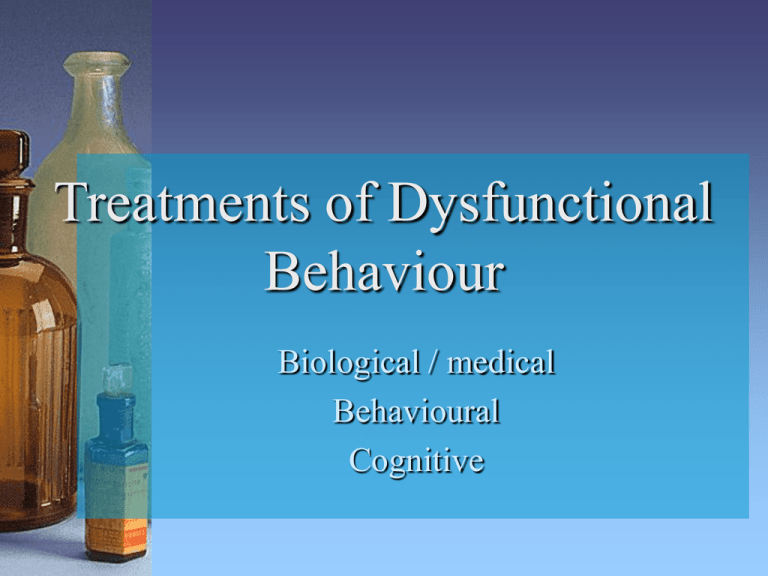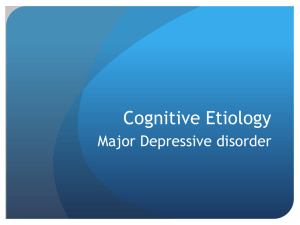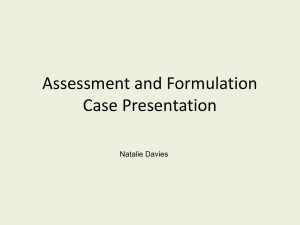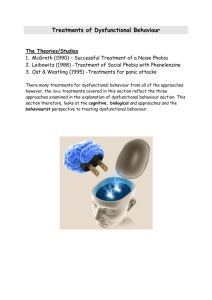Treatments of Dysfunctional Behaviour
advertisement

Treatments of Dysfunctional Behaviour Biological / medical Behavioural Cognitive The biological /medical approach The medical approach has several interventions in mental health including ECT electro convulsive therapy, surgery and most commonly use of drugs. Karp and Frank1995 studied the effects of drug therapy on depression compared to non medical interventions. Karp and Frank 1995 They reviewed research on depression in women. Some patients had drug treatments, others had one psychological treatment, others combined treatments and other placebo treatment. Depression was measured using depression inventories (psychometric tests) both before, after and sometimes during the treatments Karp and Frank 1995 Findings: Many studies found that adding psychological treatments to the drug therapy did not increase the effectiveness of the drug therapy. Occasionally studies did show less attrition when combined therapies were used (people were more likely to continue with treatment if cognitive therapy was given with drug therapy). Karp and Frank 1995 Conclusions: The evidence is that there is no improved effect when given combined therapy as compared to only drug therapy. Drug therapy is an effective way to treat depression. Behavioural treatments McGrath 1990 effective treatment for noise phobia (you need to be able to explain classical conditioning theory if this is a question in an exam) A case study of the treatment of a 9 year old girl who had a fear of sudden noises including poppers, fireworks, balloons etc. She had a lower than overage IQ but was not depressed, anxious and fearful on psychometric tests so only had one specific phobia. McGrath and noise phobia Lucy was brought to therapy sessions and at first heard a hierarchy of noises ranging from doors banging to balloons and unexpected party poppers. Lucy was taught breathing and imagery to relax and was told to imagine herself at home on her bed with her toys. She also had a pretend fear thermometer to rate her level of fear from 1 – 10. McGrath and noise phobia She was given a stimulus of noise and told to pair the stimulus with her relaxation and deep breathing and imaging being at home with her toys. After 4 sessions she learned to feel calm when the noise was presented. Findings: at the end of the first session Lucy cried and had to be taken out when a balloon popped. At the end of the session Lucy was able to pop the balloon herself. This progess continued with party poppers and guns etc. McGrath and noise phobia By the 10th session Lucy’s fear thermometer had gone from 7/10 to 3/10 for balloons popping. The researcher concluded that noise phobias in children as susceptible to systematic desensitisation. Important factors seems to be giving Lucy control over the fear response to say when and how the noises were made and then to use inhibitors of the fear response such as relaxation and a playful environment. YouTube - Beating Phobias and Anxiety Graded Exposure/ Systematic Desensitization Beck and cognitive therapy and depression Beck aimed to compared drug therapy with cognitive therapy and depression. Independent design experiment with participants randomly allocated to one of two conditions, cognitive or drug therapy. 44 patients diagnosed with moderate to severe depression were assessed using Beck’s Depression Inventory and two other rating scales. Beck and cognitive therapy and depression For 12 weeks patients wither had 1 hour cognitive therapy sessions twice a week or 100 Imipramine capsules. The therapy session were prescribed and controlled and observed to ensure reliability. Findings: both groups show a decrease in depression on all three scales. However the cognitive therapy group showed a significantly greater reduction in symptoms than the drug alone group. Beck and cognitive therapy and depression The drop out rate was 5% in the cognitive therapy group and 32% in the drug therapy group. Conclusions: cognitive therapy leads to better treatment of depression than drug therapy and also better adherence to the programme. YouTube - Cognitive Therapy: The Case of Tim Exam question Outline one way in which dysfunctional behaviour can be treated. (10) Evaluate treatments of dysfunctional behaviour (15) Next Section of the Paper The last section of the paper asks you to choose one disorder (phobia (anxiety), schizophrenia (psychotic) or depression (affective) and understand that one disorder in some depth. For your chosen disorder you should know 3 explanations and 3 treatments. The question would then be: Outline characteristics, explanations or treatments of one disorder (10) Evaluate explanations or treatments of your chosen disorder (15)








